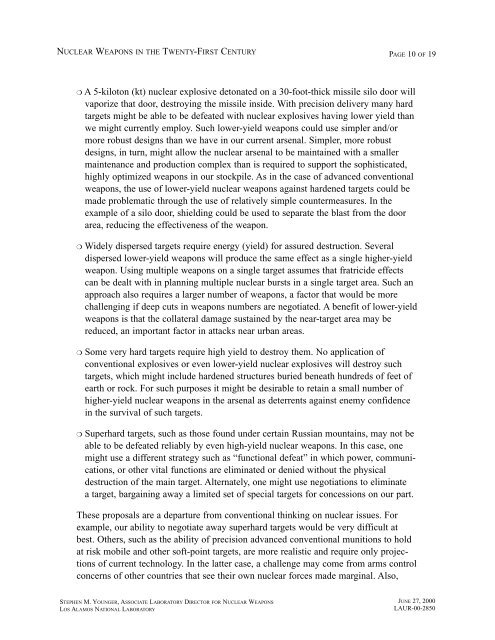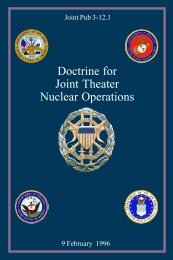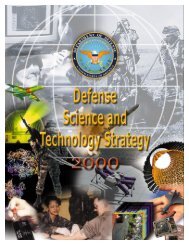Nuclear Weapons in the Twenty-First Century - Sciencemadness.org
Nuclear Weapons in the Twenty-First Century - Sciencemadness.org
Nuclear Weapons in the Twenty-First Century - Sciencemadness.org
Create successful ePaper yourself
Turn your PDF publications into a flip-book with our unique Google optimized e-Paper software.
NUCLEAR WEAPONS IN THE TWENTY-FIRST CENTURY<br />
PAGE 10 OF 19<br />
❍ A 5-kiloton (kt) nuclear explosive detonated on a 30-foot-thick missile silo door will<br />
vaporize that door, destroy<strong>in</strong>g <strong>the</strong> missile <strong>in</strong>side. With precision delivery many hard<br />
targets might be able to be defeated with nuclear explosives hav<strong>in</strong>g lower yield than<br />
we might currently employ. Such lower-yield weapons could use simpler and/or<br />
more robust designs than we have <strong>in</strong> our current arsenal. Simpler, more robust<br />
designs, <strong>in</strong> turn, might allow <strong>the</strong> nuclear arsenal to be ma<strong>in</strong>ta<strong>in</strong>ed with a smaller<br />
ma<strong>in</strong>tenance and production complex than is required to support <strong>the</strong> sophisticated,<br />
highly optimized weapons <strong>in</strong> our stockpile. As <strong>in</strong> <strong>the</strong> case of advanced conventional<br />
weapons, <strong>the</strong> use of lower-yield nuclear weapons aga<strong>in</strong>st hardened targets could be<br />
made problematic through <strong>the</strong> use of relatively simple countermeasures. In <strong>the</strong><br />
example of a silo door, shield<strong>in</strong>g could be used to separate <strong>the</strong> blast from <strong>the</strong> door<br />
area, reduc<strong>in</strong>g <strong>the</strong> effectiveness of <strong>the</strong> weapon.<br />
❍ Widely dispersed targets require energy (yield) for assured destruction. Several<br />
dispersed lower-yield weapons will produce <strong>the</strong> same effect as a s<strong>in</strong>gle higher-yield<br />
weapon. Us<strong>in</strong>g multiple weapons on a s<strong>in</strong>gle target assumes that fratricide effects<br />
can be dealt with <strong>in</strong> plann<strong>in</strong>g multiple nuclear bursts <strong>in</strong> a s<strong>in</strong>gle target area. Such an<br />
approach also requires a larger number of weapons, a factor that would be more<br />
challeng<strong>in</strong>g if deep cuts <strong>in</strong> weapons numbers are negotiated. A benefit of lower-yield<br />
weapons is that <strong>the</strong> collateral damage susta<strong>in</strong>ed by <strong>the</strong> near-target area may be<br />
reduced, an important factor <strong>in</strong> attacks near urban areas.<br />
❍ Some very hard targets require high yield to destroy <strong>the</strong>m. No application of<br />
conventional explosives or even lower-yield nuclear explosives will destroy such<br />
targets, which might <strong>in</strong>clude hardened structures buried beneath hundreds of feet of<br />
earth or rock. For such purposes it might be desirable to reta<strong>in</strong> a small number of<br />
higher-yield nuclear weapons <strong>in</strong> <strong>the</strong> arsenal as deterrents aga<strong>in</strong>st enemy confidence<br />
<strong>in</strong> <strong>the</strong> survival of such targets.<br />
❍ Superhard targets, such as those found under certa<strong>in</strong> Russian mounta<strong>in</strong>s, may not be<br />
able to be defeated reliably by even high-yield nuclear weapons. In this case, one<br />
might use a different strategy such as “functional defeat” <strong>in</strong> which power, communications,<br />
or o<strong>the</strong>r vital functions are elim<strong>in</strong>ated or denied without <strong>the</strong> physical<br />
destruction of <strong>the</strong> ma<strong>in</strong> target. Alternately, one might use negotiations to elim<strong>in</strong>ate<br />
a target, barga<strong>in</strong><strong>in</strong>g away a limited set of special targets for concessions on our part.<br />
These proposals are a departure from conventional th<strong>in</strong>k<strong>in</strong>g on nuclear issues. For<br />
example, our ability to negotiate away superhard targets would be very difficult at<br />
best. O<strong>the</strong>rs, such as <strong>the</strong> ability of precision advanced conventional munitions to hold<br />
at risk mobile and o<strong>the</strong>r soft-po<strong>in</strong>t targets, are more realistic and require only projections<br />
of current technology. In <strong>the</strong> latter case, a challenge may come from arms control<br />
concerns of o<strong>the</strong>r countries that see <strong>the</strong>ir own nuclear forces made marg<strong>in</strong>al. Also,<br />
STEPHEN M. YOUNGER, ASSOCIATE LABORATORY DIRECTOR FOR NUCLEAR WEAPONS<br />
LOS ALAMOS NATIONAL LABORATORY<br />
JUNE 27, 2000<br />
LAUR-00-2850






